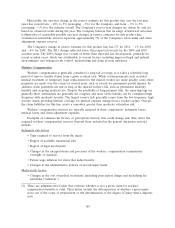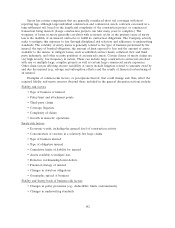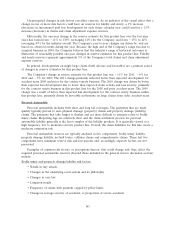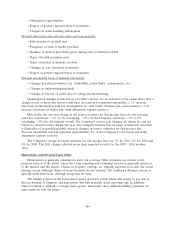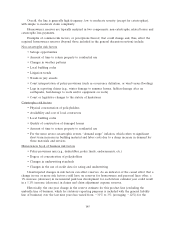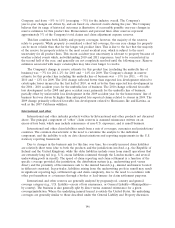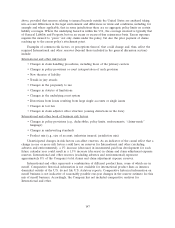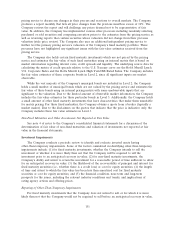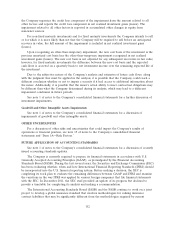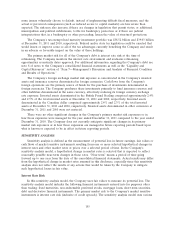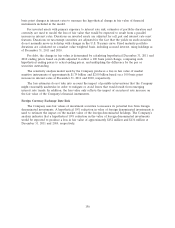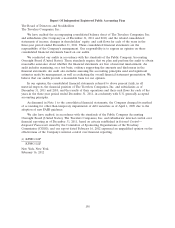Travelers 2011 Annual Report Download - page 162
Download and view the complete annual report
Please find page 162 of the 2011 Travelers annual report below. You can navigate through the pages in the report by either clicking on the pages listed below, or by using the keyword search tool below to find specific information within the annual report.forced transaction. The estimated fair value of a financial instrument may differ from the amount that
could be realized if the security was sold in an immediate sale, e.g., a forced transaction. Additionally,
the valuation of investments is more subjective when markets are less liquid due to the lack of market
based inputs, which may increase the potential that the estimated fair value of an investment is not
reflective of the price at which an actual transaction would occur.
For investments that have quoted market prices in active markets, the Company uses the
unadjusted quoted market prices as fair value and includes these prices in the amounts disclosed in
Level 1 of the hierarchy. The Company receives the quoted market prices from a third party, nationally
recognized pricing service (pricing service). When quoted market prices are unavailable, the Company
utilizes a pricing service to determine an estimate of fair value, which is mainly used for its fixed
maturity investments. The fair value estimates provided from this pricing service are included in the
amount disclosed in Level 2 of the hierarchy. If quoted market prices and an estimate from a pricing
service are unavailable, the Company produces an estimate of fair value based on internally developed
valuation techniques, which, depending on the level of observable market inputs, will render the fair
value estimate as Level 2 or Level 3. The Company bases all of its estimates of fair value for assets on
the bid price as it represents what a third-party market participant would be willing to pay in an arm’s
length transaction.
Fixed Maturities
The Company utilizes a pricing service to estimate fair value measurements for approximately 98%
of its fixed maturities. The pricing service utilizes market quotations for fixed maturity securities that
have quoted prices in active markets. Since fixed maturities other than U.S. Treasury securities
generally do not trade on a daily basis, the pricing service prepares estimates of fair value
measurements for these securities using its proprietary pricing applications, which include available
relevant market information, benchmark curves, benchmarking of like securities, sector groupings and
matrix pricing. Additionally, the pricing service uses an Option Adjusted Spread model to develop
prepayment and interest rate scenarios.
The pricing service evaluates each asset class based on relevant market information, relevant credit
information, perceived market movements and sector news. The market inputs utilized in the pricing
evaluation, listed in the approximate order of priority, include: benchmark yields, reported trades,
broker/dealer quotes, issuer spreads, two-sided markets, benchmark securities, bids, offers, reference
data, and industry and economic events. The extent of the use of each market input depends on the
asset class and the market conditions. Depending on the security, the priority of the use of inputs may
change or some market inputs may not be relevant. For some securities, additional inputs may be
necessary.
The pricing service utilized by the Company has indicated that they will only produce an estimate
of fair value if there is objectively verifiable information to produce a valuation. If the pricing service
discontinues pricing an investment, the Company would be required to produce an estimate of fair
value using some of the same methodologies as the pricing service but would have to make
assumptions for market-based inputs that are unavailable due to market conditions.
The fair value estimates of most fixed maturity investments are based on observable market
information rather than market quotes. Accordingly, the estimates of fair value for such fixed
maturities, other than U.S. Treasury securities, provided by the pricing service are included in the
amount disclosed in Level 2 of the hierarchy. The estimated fair value of U.S. Treasury securities is
included in the amount disclosed in Level 1 as the estimates are based on unadjusted market prices.
The Company reviews the estimates of fair value provided by the pricing service and compares the
estimates to the Company’s knowledge of the market to determine if the estimates obtained are
representative of the prices in the market. In addition, the Company has periodic discussions with the
150


